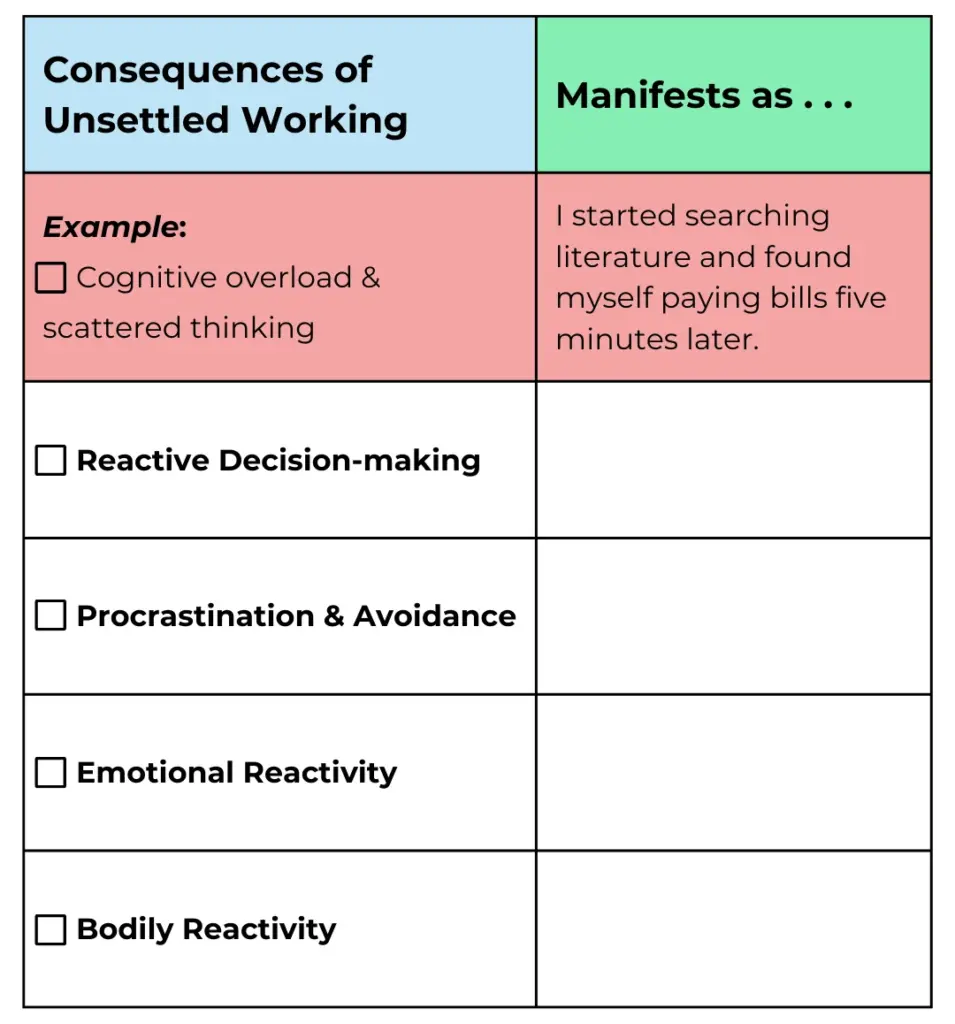The Unsettled Working Experience
Have you ever started your academic work only to find that your mind is scattered, your body is tense, and your focus is slipping away? Instead of diving in with clarity and engagement, you might feel like you’re spinning your wheels. You’re physically at your desk, but mentally somewhere else. This experience of unsettled work is abrasive to our nervous system, and it impedes our ability to clearly focus on the work at hand. Yet, many of us struggle to properly settle into our work. Driven by looming deadlines, internalized pressure, or the belief that we must always be in motion to make progress, we rush into our work in high gear. We end up unclear about what we are doing, and how we should go about doing it.
When we move into our work from an unsettled place, we carry with us all the disruptions, worries, and distractions that have accumulated throughout the day. The temptation to rush into work is completely understandable. Academia demands constant output, often without enough space to process or regulate.
We exist in a culture that rewards speed, productivity, and intellectual rigor, but rarely acknowledges the human nervous system’s need for grounding, pacing, and restoration.
In addition to academic pressures, we also absorb stress from the wider world like news cycles, personal responsibilities, financial concerns, and social expectations.
Consequences of Working From An Unsettled State
Working from an unsettled state can have big consequences. When we move into work from a dysregulated or unsettled state, one or more of the below issues might hinder our work.
Cognitive overload & scattered thinking. Instead of being able to focus, our thoughts race in multiple directions. We might start one task, then quickly jump to another, feeling overwhelmed by everything we “should” be doing.
Overcomplication. Scattered thinking can give rise to overcomplicating our work. Instead of finding clear solutions, we become prone to overcomplicate ideas or second-guess our work.
Reactive decision-making. Without a sense of inner steadiness, we often make choices based on urgency rather than importance. We might work on whatever feels most pressing rather than what truly needs our attention.
Procrastination & avoidance. If we feel internally chaotic, we may resist engaging with our work because it feels like one more source of stress. We might open and close a document repeatedly, scroll through distractions, or convince ourselves we need more preparation before we can begin.
Emotional reactivity. When we’re unsettled, minor challenges feel much bigger. A difficult paragraph can make us feel like we’re failing. A critical comment from an advisor or reviewer can shake our confidence more than it might otherwise.
Bodily reactivity. Your mind is not the only part of you that is affected by unsettled working. An unsettled state also affects the body. Shallow breathing, tight shoulders, or a clenched jaw can signal that we’re carrying stress into our work. You might also find yourself fighting fatigue that comes on or worsens right as you begin to work. These bodily reactions make it harder to sustain focus and can contribute to burnout over time.
Falling into one or more of these tendencies is not the end of the world (or your work session). If we build check-ins into our work time, we can become aware of our tendencies; they can become clues to remind ourselves to settle in (or back in) to our work.
Use the below checklist to help you notice any tendencies that might signal that you are unsettled:

Working from a Settled State
Though settling in may not always be easy, we don’t have to work from an unsettled state. In order to settle in, we don’t have to wait until we feel 100% calm to begin our work. We do not need to avoid our work until all distractions disappear. To settle in, we simply need to take a moment to shift from a reactive state, into a more centered one.
Our programming might encourage us to move as quickly as possible into our work, thinking that we don’t have time to settle in, but settling in actually increases our focus and productivity.
Settling in increases productivity by creating conditions that enhance our focus. When we move into work from a more settled state, we are able to:
Think more clearly. Instead of jumping between scattered thoughts, we can hold a clearer direction for our work. Ideas connect more easily, and we can access deeper levels of reasoning and creativity.
Feel more present. We’re less caught in the past (ruminating on what we should have done), or the future (worrying about what still needs to happen). We engage with the work in front of us as it unfolds.
Make thoughtful choices. Instead of reacting to what feels most urgent, we can pause to assess what truly matters. We’re more intentional with our time, energy, and focus.
Sustain focus with less strain. Rather than forcing ourselves to work through tension, we align our efforts with a steadier internal rhythm. This allows us to be productive without feeling drained.
Navigate challenges with more resilience. Writing and research always involve obstacles, but when we’re more settled, we can meet difficulties with curiosity rather than frustration. We’re less likely to spiral into self-criticism or discouragement.
The above results of settled work are well worth taking a couple of moments to transition into our work by setting in. If you are thinking, “Great, but how?” read on and learn practices for settling in.
How to Settle into Academic Work
There is no one way to settle in that works for everyone, but the below exercises a good place to start. Before you dive into your work, use the following steps to check in with yourself.
1. Pause & notice. Sit comfortably and take a slow breath. Notice how you feel, physically, mentally, and emotionally. Name that feeling (“Today, I feel . . . “).
2. Ground yourself. Let your attention settle on the present moment. Feel your feet on the floor, your body in the chair.
3. Set an intention – Ask yourself, “What would it mean to engage with my work from a more settled place?” Then answer that question.
4. Begin with awareness. Start your session with the mindset that you are arriving into your work, rather than forcing yourself through it.
Settling into academic work is akin to stretching your muscles before a workout. You wouldn’t break into a full sprint on a track; nor do you need to barrel into your academic work full-speed-ahead to make progress.
Easing into academic work can look like:
• Warming up with easier tasks.
• Free writing for 5 minutes to clear mental clutter, or warm up your thinking.
• Skimming your outline or structure to reconnect with the flow of your project.
• Reorganizing your workspace to create clarity and remove distractions.
• Speaking your plan out loud—saying, “I’m going to spend 20 minutes on this section…” to focus your intention.
However you choose to ease into your academic work, the key is to do so slowly, which gives your mind time to transition into the work.
You Don’t Have to Force Your Work
Settling in before we begin is not about delaying progress; it’s about creating the best conditions for engagement. We often think of work as something we have to push through, but what if we approached it with the steadiness that comes from grounding ourselves first?
The next time you sit down to write, remember: you don’t need to be perfectly calm or fully ready. Even a brief pause to settle in can shift your experience, inviting greater clarity, ease, and effectiveness as you engage with your work.

